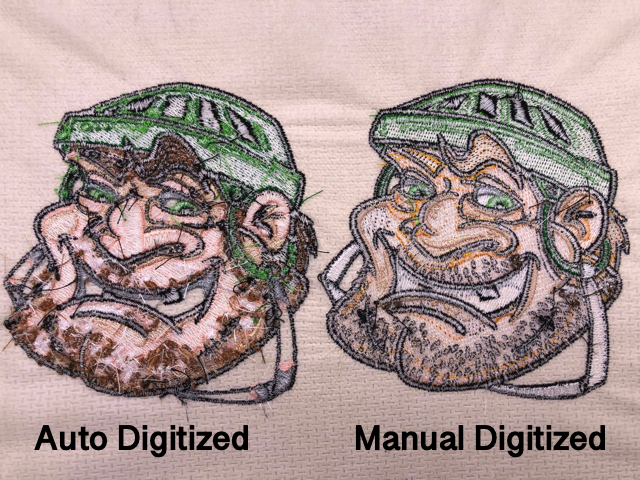Streamlining the Art of Embroidery Digitizing: Step-by-Step Overview
Needlework digitizing is a meticulous craft that requires accuracy and imagination. As technology remains to breakthrough, the digitization procedure has ended up being much more available, allowing fanatics to bring their complex styles to life with simplicity. In this guide, we will certainly untangle the intricacies of embroidery digitizing, damaging down each action systematically to streamline the procedure and equip both beginners and skilled embroiderers alike. Remain tuned to discover just how you can simplify this elaborate art form and change your innovative visions right into magnificently embroidered work of arts.
Understanding Embroidery Digitizing Software Application
Needlework digitizing software program works as a crucial device for changing intricate designs into digital layouts compatible with embroidery makers, helping with exact sewing and personalization. This customized software program allows individuals to import numerous image data styles, such as JPG or PNG, and transform them into embroidery machine-readable styles like DST, EXP, or PES - Digitizing for Embroidery. By utilizing functions like stitch editing, underlay choices, and thread color choice, digitizing software program enables users to control every element of the style procedure
In addition, progressed needlework digitizing software offers tools for producing complicated styles, changing stitch thickness, and incorporating elaborate information. Users can likewise preview the design prior to sewing it out, making certain precision and decreasing mistakes. Additionally, many software programs offer automatic features that help simplify the digitizing procedure, conserving time and initiative.
Comprehending the capacities of needlework digitizing software program is essential for achieving high-quality cause embroidery tasks. By understanding this device, needlework fanatics and specialists can release their creative thinking and bring detailed designs to life with precision and effectiveness.

Picking the Right Layout Documents
After familiarizing yourself with the capacities of needlework digitizing software application, the next crucial action in the process is picking the ideal layout file for your job. Digitizing for Embroidery. When choosing a style file for needlework digitizing, it's important to take into consideration the complexity of the design, the size of the end product, and the sort of material you will be collaborating with
For detailed layouts with fine details, a high-resolution photo or vector file is recommended to guarantee that the embroidery machine can properly recreate the design. In addition, the dimension of the final item plays a substantial function in selecting the appropriate style file. Larger layouts might need greater resolution documents to keep clearness and sharpness.
Furthermore, the kind of fabric you will certainly be stitching on influences the option of layout file. Various textiles may need changes in the design documents to ensure that the stitches are correctly straightened and the design appears as planned. By carefully picking the right style documents based on these aspects, you can establish yourself up for a successful needlework digitizing process.
Digitizing Tools and Methods
Making use of specialized software application and accuracy techniques, digitizing tools are crucial in transforming complex layouts right into embroidery-ready documents. Needlework digitizing software program, such as Wilcom, Hatch, or Embrilliance, offers the needed platform to transform try this website art work into stitch information. These programs offer functions like stitch modifying, rug choices, and text devices to make sure the layout converts flawlessly onto textile.
Among the vital strategies in digitizing is developing a clear course for the needlework equipment to adhere to. This entails digitizing each component of the style with accuracy, figuring out stitch kinds, thickness, and directions. By utilizing tools like digitizing tablets or software-specific plugins, embroiderers can achieve a high level of accuracy in their digitized layouts.
Furthermore, mastering the art of underlay sewing is crucial for producing quality embroidery. Underlay stitching maintains the fabric and produces a foundation for the design, making sure that the last item is both aesthetically enticing and durable. By recognizing these digitizing tools and techniques, embroiderers can elevate their craft and bring intricate layouts to life with accuracy and effectiveness.
Personalizing Stitch Types and Directions
The selection of stitch types can substantially affect the general look and appearance of the stitched design. By strategically incorporating these stitch kinds, embroiderers can attain depth and dimension in their designs.
In addition, the instructions of stitches plays an essential duty in improving the aesthetic allure of the final needlework. Numerous stitch instructions can add appearance, highlight particular components, and produce aesthetic passion. For example, changing the angle of stitches can mimic activity or all-natural patterns like fur or feathers. By try out different stitch angles and patterns, embroiderers can bring their designs to life with remarkable detail and complexity. Understanding the art of personalizing stitch types and instructions encourages embroiderers to unleash their creativity and raise the high quality of Full Report their work.
Screening and Refining Your Digitized Design
To ensure the accuracy and quality of your digitized design, comprehensive screening and improvement are essential action in the needlework digitizing procedure. As soon as you have finished the digitization of your design, it is critical to evaluate it before continuing with the actual needlework. Examining permits you to determine any possible concerns such as string breaks, stitch density troubles, or layout distortions that may affect the result.

After screening, it is crucial to improve your digitized style based on the feedback from the click for source test sew-out. This may involve tweaking sew settings, adjusting densities, or making modifications to the total design to accomplish the desired end result. By iterating through screening and refinement, you can adjust your digitized design to perfection prior to relocating ahead with the actual needlework procedure.
Final Thought
Finally, grasping the art of needlework digitizing needs a comprehensive understanding of the software program, picking the appropriate layout documents, utilizing digitizing tools and methods, personalizing stitch types and directions, and screening and refining the digitized design. By adhering to these actions, embroiderers can simplify the digitizing process and produce top quality stitched layouts with accuracy and efficiency.